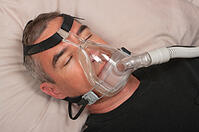Men with overweight or obesity and moderate to severe obstructive sleep apnea receiving CPAP assigned to undergo an interdisciplinary weight loss and lifestyle intervention had improved outcomes and health-related quality of life.
The Interdisciplinary Weight Loss and Lifestyle Intervention for OSA (INTERAPNEA) study, a parallel-group, open-label, randomized clinical trial, included 89 men (mean age, 54.1 years) in Spain with moderate to severe OSA and a BMI of 25 kg/m2 or higher who were receiving CPAP therapy. The trial was conducted from April 2019 to October 2020.
Participants were randomly assigned to usual care with CPAP therapy (n = 49) or an 8-week interdisciplinary weight loss and lifestyle intervention involving nutritional behavior change, aerobic exercise, sleep hygiene and alcohol and tobacco cessation along with CPAP therapy (n = 40).
The primary outcome was a change in the apnea-hypopnea index from baseline to 8 weeks and 6 months after the intervention. Secondary outcomes included changes in other OSA sleep-related outcomes, body weight and composition, cardiometabolic risk and health-related quality of life.
Participants in the intervention group had a 51% greater decrease in the apnea-hypopnea index compared with participants in the control group (–21.2 vs. 2.5 events/hour) at 8 weeks. This reduction was 57% greater among participants in the intervention group at 6 months (–23.8 vs. –0.8 events/hour).
Forty-five percent of participants in the intervention group no longer required CPAP therapy and 15% achieved complete OSA remission by 8 weeks. At 6 months, 61.8% of participants in the intervention group no longer required CPAP therapy and 29.4% achieved complete OSA remission.
In addition, the intervention group had greater improvements compared with the usual care group in body weight (–7.1 kg vs. –0.3 kg), body composition (–2.9 kg vs. 1.4 kg), cardiometabolic risk (–6.5 mm Hg vs. 2.2 mm Hg) and health-related quality of life (0.8 points vs. 0.1 points) by 8 weeks.
“Given the high prevalence of OSA, its complex and reciprocal interaction with obesity and the fact that both conditions are readily treatable through an integrated behavioral intervention, health care professionals and policymakers might consider this approach as a central strategy to address the substantial impact of OSA on the health and welfare of populations,” Almudena Carneiro-Barrera, PhD, of the Sleep and Health Promotion Laboratory, Mind, Brain and Behavior Research Centre at the University of Granada in Spain, and colleagues wrote in JAMA Network Open.
Therapy for Obstructive Sleep Apnea

- Positive Airway Pressure (PAP). The majority of OSA sufferer’s symptoms are often relieved through the use of a PAP machine. PAP machines are devices that use masks that fit over the wearer’s nose, nose and mouth, or full face and deliver a gentle force of air that pushes past the blockage to allow for easier breathing at night. There are 3 kinds of PAP machines for differing needs, but the CPAP therapy is the most common.
- Continuous Positive Airway Pressure (CPAP). A CPAP device includes a breathing mask that sleep apnea sufferers wear when sleeping. Just enough consistent air pressure is delivered via the mask to the patient’s airways to keep the tissue that otherwise would collapse (and cause breathing pauses and snoring) from closing during sleep. CPAP devices are effective in treating sleep apnea but do not cure the disorder. If you discontinue using your CPAP device, your sleep apnea may return.
- Automatic Positive Airway Pressure (APAP). Automatic, or autotitrating, positive airway pressure adjusts to the air levels sleep apnea patient needs throughout the night. An APAP can detect if the patient’s apnea is spiking and increase the air pressure, then decrease the flow if the sufferer is at a peaceful, non-snoring state. APAP therapy is useful for people who can’t get comfortable with a CPAP’s air pressure, or for people with seasonal allergies whose breathing might be affected at different times during the night.
- Bilevel positive airway pressure (BPAP). Bilevel positive airway pressure is similar to CPAP except that BPAP adjusts the level of air being delivered depending on whether the patient is inhaling or exhaling. During inhalation, an electronic sensor tells the BPAP to send more air through the mask to clear the apnea-causing obstruction. When the user exhales, the air pressure is reduced. This decrease is helpful for sleep apnea sufferers who have a rough time breathing out against the constant pressure of a CPAP machine.
- Adaptive-servo ventilation (ASV). The Adaptive-servo ventilation device monitors breathing and adjusts air flow appropriately through the mask to match how the patient would be normally breathing if awake. This adjustment can be made quickly as soon ASV detects that the patient is not breathing correctly (as is the case with central sleep apnea, when the brain doesn’t signal the body to take a breath). When the patient exhales or after the patient resumes a normal breathing pattern, ASV adjusts the pressure again.
- Oral Appliances
- Mandibular advancement devices. Often used for snorers, mandibular advancement devices (MADs) also can be helpful in curbing sleep apnea. MADs look like sports mouthguards and push the lower jaw down slightly, just enough to pull the tongue forward and help open the air passage.
- Tongue-retaining mouthpieces. Also common as a snoring treatment, tongue-retaining mouthpieces are worn in the mouth and change the position of the tongue during sleep. The flow of air through the user’s mouth becomes less obstructed and may help lessen obstructive sleep apnea.
- Surgery for obstructive sleep apnea
Some patients find wearing a PAP machine’s mask or using an oral appliance too inconvenient. Most often it’s because they have difficulty wearing a mask on their face, a device in their mouth, or find the pressure of air blown into their nose throughout the night uncomfortable.
For the non-compliant, surgical alternatives for obstructive sleep apnea may be a practical alternative.
However, as OSA can be caused by different obstructions, the type of surgery will be specific to each individual. Some of the most common forms of OSA related surgeries are:
- Uvulopalatopharyngoplasty (UPPP). A procedure in which soft tissues in the back of the throat are removed. The tissues removed are from the uvula (the little soft flap of tissue that dangles in the back of the throat) and parts of the soft palate. If tonsils and adenoids are still intact, they are often removed as well.
- Adenotonsillectomy. Surgical removal of enlarged adenoids and tonsils is usually the first line of treatment in children with obstructive sleep apnea.
- Nasal Surgery. For OSA sufferers whose symptoms are often caused by a deviated septum, the straightening of the nasal passages or removal of the deviated cartilage can help free up the blockage causing snoring and OSA.
- Maxillomandibular Advancement (MMA). In this surgery, the upper and lower parts of the jawbone are moved forward. It creates an enlarged space behind the tongue and soft palate, making obstructions less likely.
- Tracheostomy. In the most severe and potentially life-threatening cases of
obstructive sleep apnea, it may be recommended that the patient undergo a tracheostomy. In this surgical procedure, a permanent opening is made in the throat to the windpipe where a breathing tube is inserted. The breathing tube has a valve that is closed during the day for regular breathing and speaking and opened at night. When opened during sleep, air enters the lungs through the tube rather than through the upper airways allowing airflow to bypass the obstruction by entering beneath it. - What Can Happen If My OSA is Left Untreated?
- It’s important that you address your OSA symptoms early to avoid any further health complications that can arise from untreated obstructive sleep apnea. These complications can range from severe and potentially fatal to mild or moderate daily nuisances.
- Cardiovascular problems.Untreated obstructive sleep apnea can cause a strain on your heart as sudden drops in blood oxygen levels that occur during OSA increases your blood pressure. High blood pressure (hypertension) increases the likelihood of a number of heart diseases and complications:
- Abnormal heart rhythms (arrhythmia)
- Greater risk of coronary artery disease.
- Greater risk of heart attack or heart failure.
- Greater risk of having a stroke.
- Daytime fatigue.Untreated OSA keeps your body and mind from getting a full night’s sleep as you continuously wake because of breathing obstructions disturbing your sleep. This leaves sufferers feeling tired and groggy throughout the day. People with untreated OSA have a higher likelihood of work related accidents and driving related accidents resulting from lack of restful sleep at night.
- Complications with medications and surgery. Medications such as sedatives, narcotic analgesics, and general anesthesia all aid in relaxing your upper airways that can further complicate your OSA.
- Other Problems associated with untreated OSA
- Memory problems
- Morning migraines due to reduced blood oxygen in the brain at night.
- Mood swings.
- Depression.
- If you have any questions or concerns regarding obstructive sleep apnea or any other sleep related questions, feel free to contact The Alaska Sleep Clinic for further information and be on your way to getting the nightly rest you need.












